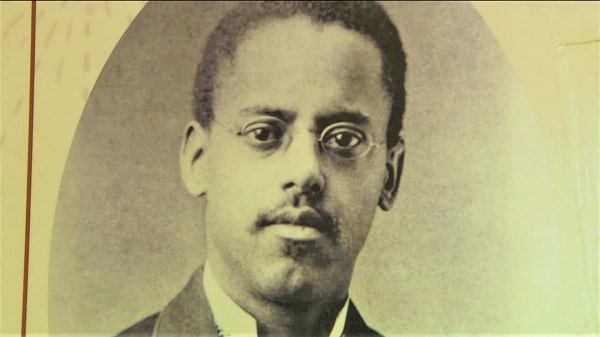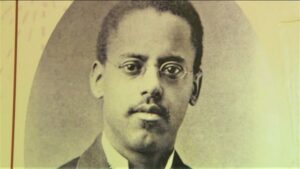

Lewis Howard Latimer (born September 4, 1848, in Chelsea, Massachusetts, Died on December 11, 1928, in Flushing near Queens, New York) was an inventor, patent expert of the electronics industry in the early days, author of a specialist book and a poetry book. He spent a large part of his working life in Thomas Alva Edison companies.
At the beginning of his life, he was amid the social upheavals of the time, affected by slavery, and actively involved in the civil wars. Afterward, he was actively involved in the technological revolution of electrification, worked for several important electrical companies of the early days, and was at the forefront of and shaped their struggles for market share and the defense of their innovations.
He was involved in drawing up one of the most important patents of the 19th century, the telephone patent of Alexander Graham Bell. Another patent of the century, the light bulb patent By Thomas Alva Edison, he has served as a technical expert and patent expert in numerous legal proceedings, defending against fraudulent anticipation claims and other challenges.
Lewis Howard Latimer is an early example of African American achievements in building modern industries in the United States of America.
Quick Facts: Lewis Howard Latimer
- Born: 4 September 1848, Chelsea, Massachusetts, United States
- Also known As: Lewis Latimer
- Known For: Inventing the incandescent light bulb
- Parents: George W. Latimer (1818–1896), Rebecca Smith (1823–1910)
- Siblings: Margaret Ann Latimer, William H. Latimer, George W. Latimer
- Spouse: Mary Wilson Lewis (m. 1873)
- Children: Jeanette Latimer (married: Gerald F. Norman) Louise Latimer
- Occupation: Inventor, Author, Engineer, Patent Consultant, Draftsman, Navy Landsman (Rank)
- Died: December 11, 1928, in Flushing, Queens, New York
- Books: Incandescent Electric Lighting: A Practical Description of the Edison System
- Quotes: We create our future, by well improving present opportunities: however few and small they be. – Lewis Howard Latimer
The Early Life of Lewis Howard Latimer
Lewis Howard Latimer was born on September 4, 1848, in Chelsea, Massachusetts is the youngest of four children, George W. Latimer, and Rebecca Latimer. George Latimer worked as a slave for various owners in Virginia until the end of 1842, a few months after marrying Rebecca Smith.
The young couple decided to flee to abolitionist states north of the Mason-Dixon line to get out of slavery and provide their children with better living conditions.
The couple is arrested in Boston at the request of their owner James Gray, after a heated trial, it is decided that George Latimer is returned to his master, but abolitionists led by Frederick Douglass and William Lloyd Garrison, propose to buy his freedom, James Gray accepts the redemption for an amount of $400, the couple is freed in 1848.
Following the passions raised around the Latimer trial, the State of Massachusetts promulgated prohibiting the prosecution of fugitive slaves. George Latimer works as a hairdresser/barber and upholsterer.
Lewis follows primary school until the age of 10 at Phillips Grammar School in Chelsea, he helps his father in his upholsterer activity, then he becomes an office worker in the lawyer’s office Issac Hull Wright. On September 16 1863, during the American Civil War, cheating on his age, he joined the navy, he was a sailor on the USS Massasoit (1863).
Marriage
He returned to Boston, Massachusetts, and took a job as an office boy with the patent law firm Crosby & Gould. He brought himself drawing and elaborating draftsman at the company. In recognition of Latimer’s talent and promise, the partners encouraged him and illustrator, eventually head writers.
During this time he married Mary Wilson in November 1873. The couple had two daughters, Emma Jeanette (born June 12, 1883) and Louise Rebecca (born April 19, 1890).
Working with Alexander Graham Bell
In 1874, while at the company, Latimer invented an improvement for the bathroom room trains-co. Two years later he was sought as a draftsman by a teacher of children who were hard of hearing; the man wanted drawings for a patent application on a device he had created. The teacher was Alexander Graham Bell and the device was the phone.
Working late into the evening, Latimer worked to complete the patent application. It was submitted on February 14, 1876, just a few hours before further use was made for a similar device. With the help of Latimer, Glocke won the patent rights to the telephone.
The collaboration with Hiram Maxim
In 1880 Latimer was hired as an executive assistant and designer draftsman by Hiram Maxim, chief engineer of Electro-Dynamic Light Company, a company founded in 1878 which was the first to distribute electricity and manufacture incandescent bulbs.
It is in this context that he will develop an electric bulb with a carbon filament, in 1881. Latimer directs the installation of electric light in Philadelphia. He did the same in Montreal, where he learned enough French to make sure that the workers understood his instructions.
He was then sent to London, where he was responsible for setting up a factory for incandescent lamps for the Electro-Dynamic Light Company. He also developed a new wiring diagram, using parallel circuits, for public lighting systems, so that if one bulb burned out, the others would continue to light.
The collaboration with Thomas Edison
In 1884, he was hired as an engineer by the General Electric Company of Thomas Edison. He is the only African American member of the Edison Pioneers research team there.
After many tests, Thomas Edison appoints John Latimer to find a durable filament for light bulbs, Latimer improves his previous patent by protecting the carbon filament and April 29, 1884, Thomas Edison can thus file a new patent for an incandescent lamp.
Thomas Edison encourages Latimer to publish his works, this is how Incandescent Electric Lighting: A Practical Description of the Edison System is published, with supplements from his collaborators CJ Field and John White Howell by D. van Nostrand editions Company.
Lewis Howard Latimer Innovations
In the following years, Latimer continued to display its innovative skills. In 1894, he created a safety elevator, a major improvement over existing elevators. Then he received a patent for “locking racks for hats, coats and umbrellas”, which was used in restaurants, resorts, and office buildings.
He also developed a process for making room hygienic and climate-controlled, called a “device for cooling and disinfecting.”
Lewis Howard Latimer Death
Lewis Howard Latimer died on December 11, 1928 in Flushing near Queens, New York. His wife Mary had died 4 years earlier.